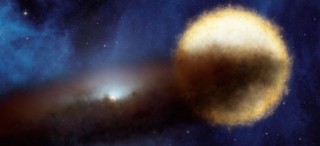
Researchers at the Departamento de Astronomia UdeC discover rare species of Binary Star
In neighboring Large Magellanic Cloud galaxy, scientists were able to identify ELHC10, a new and unique binary star that has large discs of dark and eclipsing gas. The object also draws attention by having a circunbinary disk and a mirrored spectrum whose origin astronomers still can not solve.
Binary type stars are the most abundant in the universe and to date only in our Milky Way there have been identified a dozen binaries similar to star in question, with irregular eclipses and spectral properties that show evidence of a dark gas producing eclipses of up to 2 years in some cases. However, they have not yet been able to determine if they all have the same state of evolution and it is unknown how they have managed to form their striking gas disks.
The group of astronomers consisting of Hernán Garrido (UCSC), Dr. Ronald Mennickent (UdeC) and Dr. Gorjo Djurasevic (Observatory of Belgrade, Serbia) set out to make a systematic study of the star ELHC10, a new member of this kind of binary. “We found that it has an orbital period of 219.9 days and a Post-AGB giant star orbiting a massive star surrounded by a dark disk of gas. The system could represent a new evolutionary track for post-AGB stars, where the formation of a circumstellar disk is a direct result of mass transfer between the stars, “says Dr. Mennickent, one of the principal investigators of the study.
“This is the second object of this class that hs been reported in the Large Magellanic Cloud and, on the other hand, the other known objects are, generally, systems with longer periods than ELHC10. The system with longer period is Epsilon Aurigae, whose cycle is about 27.12 years and its eclipse lasts about two years, which is why the ELHC10 becomes a very favorable object to understand the possible evolutionary tracks of these long period systems” said Dr. Hernan Garrido, who along with his team studied since 2010 this star that stood out for its high luminosity, but soon showed valuable information for the study of the evolution of binary stars.
To identify all the features of this new kind of binary, astronomers made use of the HARPS spectrograph mounted on a 3.6-meter telescope at La Silla Observatory, it was also necessary to use the spectrograph MIKE and 6.5-meter Clay telescope located in Las Campanas Observatory, plus the Echelle spectrograph located at the telescope Irenee du Pont 2.5 meters from the same observatory in northern Chile.
The next step is to conduct a thorough investigation of all objects with eclipsing disks to determine the relationship between them. “We want to determine how they have formed their disks and if this formation is a consequence of their evolutionary states. We also want to make a systematic study of radial velocities of post-AGB stars to determine the binary fraction and understand to what extent the interaction phenomena influence the evolution leading to the formation of planetary nebulae, “concludes Mennickent.





